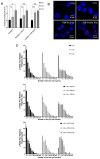Evaluation of a Rhenium(I) Complex and Its Pyridostatin-Containing Chelator as Radiosensitizers for Chemoradiotherapy
- PMID: 40807413
- PMCID: PMC12348617
- DOI: 10.3390/molecules30153240
Evaluation of a Rhenium(I) Complex and Its Pyridostatin-Containing Chelator as Radiosensitizers for Chemoradiotherapy
Abstract
The use of radiosensitizers is a beneficial approach in cancer radiotherapy treatment. However, the enhancement of radiation effects on cancer cells by radiosensitizers involves several different mechanisms, reflecting the chemical nature of the radiosensitizer. G-quadruplex (G4) DNA ligands have emerged in recent years as a potential new class of radiosensitizers binding to specific DNA sequences. Recently, we have shown that the Re(I) tricarbonyl complex PDF-Pz-Re and its pyrazolyl-diamine chelator PDF-Pz, carrying a N-methylated pyridostatin (PDF) derivative, act as G4 binders of various G4-forming DNA and RNA sequences. As described in this contribution, these features prompted us to evaluate PDF-Pz-Re and PDF-Pz as radiosensitizers of prostate cancer PC3 cells submitted to concomitant treatment with Co-60 radiation. The compound RHPS4 was also tested, as this G4 ligand was previously shown to exhibit strong radiosensitizing properties in other cancer cell lines. The assessment of the resulting radiobiological effects, namely through clonogenic cell survival, DNA damage, and ROS production assays, showed that PDF-Pz-Re and PDF-Pz were able to radiosensitize PC3 cells despite being less active than RHPS4. Our results corroborate that G4 DNA ligands are a class of compounds with potential interest as radiosensitizers, deserving further studies to optimize their radiosensitization activity and elucidate the mechanisms of action.
Keywords: Co-60 irradiation; G4-DNA binders; Re(I) complexes; pyridostatin derivatives; radiosensitizers.
Conflict of interest statement
The authors declare no conflicts of interest.
Figures





Similar articles
-
Prescription of Controlled Substances: Benefits and Risks.2025 Jul 6. In: StatPearls [Internet]. Treasure Island (FL): StatPearls Publishing; 2025 Jan–. 2025 Jul 6. In: StatPearls [Internet]. Treasure Island (FL): StatPearls Publishing; 2025 Jan–. PMID: 30726003 Free Books & Documents.
-
Targeting of G-quadruplex DNA with 99mTc(I)/Re(I) Tricarbonyl Complexes Carrying Pyridostatin Derivatives.Chemistry. 2024 Apr 16;30(22):e202400285. doi: 10.1002/chem.202400285. Epub 2024 Mar 8. Chemistry. 2024. PMID: 38386665
-
EORTC guidelines for the use of erythropoietic proteins in anaemic patients with cancer: 2006 update.Eur J Cancer. 2007 Jan;43(2):258-70. doi: 10.1016/j.ejca.2006.10.014. Epub 2006 Dec 19. Eur J Cancer. 2007. PMID: 17182241
-
In-depth analysis of the mode of action of resveratrol: genome-wide characterization of G-quadruplex binding properties.Cell Mol Biol Lett. 2025 Jun 20;30(1):74. doi: 10.1186/s11658-025-00747-1. Cell Mol Biol Lett. 2025. PMID: 40542407 Free PMC article.
-
Management of urinary stones by experts in stone disease (ESD 2025).Arch Ital Urol Androl. 2025 Jun 30;97(2):14085. doi: 10.4081/aiua.2025.14085. Epub 2025 Jun 30. Arch Ital Urol Androl. 2025. PMID: 40583613 Review.
References
MeSH terms
Substances
Grants and funding
LinkOut - more resources
Full Text Sources
Research Materials

